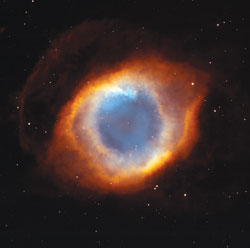 It is the nature of human beings to be curious, and our species has the capacity to inquire and explore. Who possesses these qualities in abundance more than us astronomers, both amateurs and professionals?
It is the nature of human beings to be curious, and our species has the capacity to inquire and explore. Who possesses these qualities in abundance more than us astronomers, both amateurs and professionals?
Exploring the universe satisfies not only our intellectual need to know, but also provides an emotional satisfaction through the wonder and awe we experience when we consider the vastness of the universe compared to the small speck of dust that is our home planet, Earth.
Those folks who are not familiar with stargazing might be sceptical if I say that there is incredible beauty and inspiration to be found in the depths of the sky. The globular cluster of 300,000 stars in Hercules, known as M13, or the Helix Nebula (NGC 7293) in Aquarius would be just as popular for their grandeur as any terrestrial wonder like Mt Everest or the Pyramids of Egypt.
But the problem here is that many of the celestial objects are not available to the naked eye, and we need the help of a telescope to see them. Therefore, let's do everything in our power to take astronomy to the citizens! The government should consider providing binoculars and telescopes to schools and colleges.
Back to business. The warm, clear skies of October provide a wealth of viewing opportunities. After sunset, you could see the zodiacal constellations of Taurus, Aries, Pisces, Aquarius and Capricornus from east to west. Just overhead, find the Great Summer Triangle formed by three brilliant stars: Vega, Deneb and Altair. To the east of the Summer Triangle there is the Square of Pegasus, which looks like a large box-shaped figure. In the southern skies, you can enjoy a lonely white star, Formalhaut at the 'mouth' of the Southern Fish.
Regarding planets, Mercury sets only a few minutes after sunset and is at inferior conjunction (in front of the Sun) on 23 October, so we won't see it this month. Venus is a spectacular 'Morning Star' rising in the east just after 3am. It reaches greatest elongation west of the Sun (46 degrees) on 28 October. Mars is rising in the north-east at about 10pm and appears significantly brighter than any of the nearby stars.
You could still find Jupiter in the western sky after sunset but the 'King of Planets' grows dim throughout October. Saturn is rising in the early hours of the morning, and is well up in the south-east by dawn. Don't miss the meeting of Saturn, Venus and the crescent Moon on 7-8 October in the pre-dawn sky. On 3 October you could enjoy the meeting of Mars and the crescent Moon.
There are a couple of meteor showers to entertain us during Dasain. The Draconids are a very brief storm lasting only one day - on 9 October! The Orionids are usually the best shower of October, peaking on 21 October. You could catch as many as 25 meteors an hour. These are bits of Halley's Comet and produce fine trails that swiftly disappear. At the end of the month the Taurids begin, peaking in early November.
Finally, there's one bit of exciting news from NASA: the Dawn spacecraft blasted off on 26 September to visit two of the largest asteroids in the solar system - Ceres and Vesta. No other spacecraft has ever orbited two bodies after leaving Earth.
I wish you all clear skies and a Happy Dasain!


